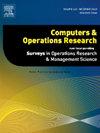A pharmaceutical distribution network considering supply cycles, waste, and inequity
IF 4.1
2区 工程技术
Q2 COMPUTER SCIENCE, INTERDISCIPLINARY APPLICATIONS
引用次数: 0
Abstract
Perishable essential medicine products, especially in the context of developing countries, have suffered a challenge in terms of distribution budget. Moreover, distribution equity, sustainability, as well as replenishment cycles are critical characteristics for developing a careful and efficient distribution strategy for perishable medical products. To the best of our knowledge, this article is the first attempt to propose an optimisation model for the distribution network of perishable medical products by considering equity, supply waste, and replenishment cycle in the limited supply context. The proposed model is formulated as Mixed Integer Linear Programming (MILP) and solved using Variable Neighbourhood Search (VNS)-based matheuristic procedure. A new method referred to as the Learning VNS is developed as an alternative procedure to overcome the limitations of the current matheuristic approach. This approach endows the learning process for the exploration of the neighbourhood. To demonstrate practical employment, the proposed model and its solution method were applied to 12 instances in Indonesia’s COVID-19 contexts. The instances were developed under different thresholds of waste, inequity, and number of hubs. We found that the proposed model can effectively be solved through the proposed solution method. The computational experiments exhibit the attainability to develop an efficient distribution network with a consideration of waste and inequity. An outline of emerging research directions is presented in the last section of this article.
求助全文
约1分钟内获得全文
求助全文
来源期刊

Computers & Operations Research
工程技术-工程:工业
CiteScore
8.60
自引率
8.70%
发文量
292
审稿时长
8.5 months
期刊介绍:
Operations research and computers meet in a large number of scientific fields, many of which are of vital current concern to our troubled society. These include, among others, ecology, transportation, safety, reliability, urban planning, economics, inventory control, investment strategy and logistics (including reverse logistics). Computers & Operations Research provides an international forum for the application of computers and operations research techniques to problems in these and related fields.
 求助内容:
求助内容: 应助结果提醒方式:
应助结果提醒方式:


